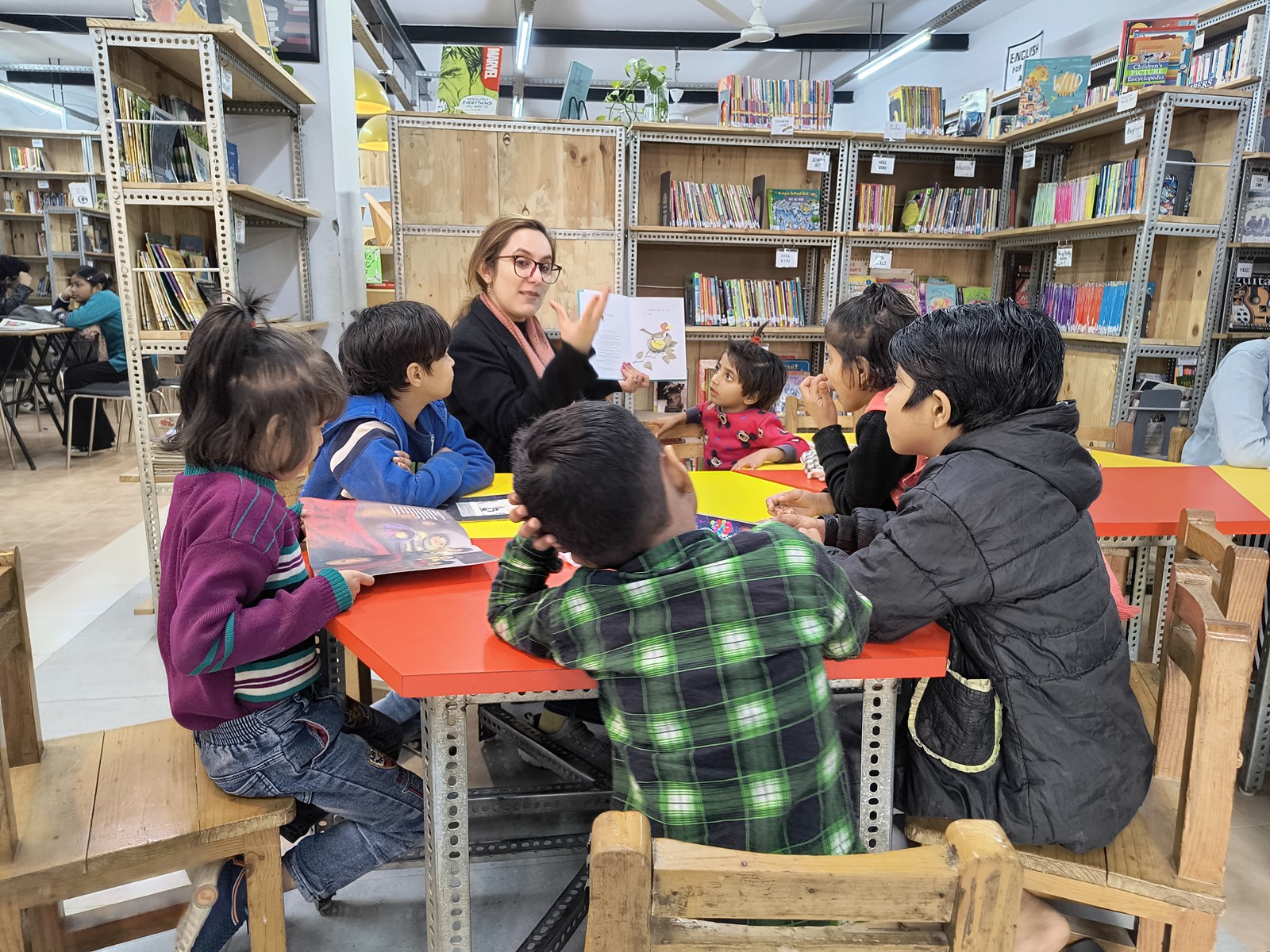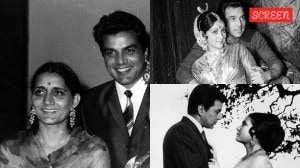The free libraries of India telling stories of hope
Run without government aid, libraries are popping up in under-resourced places around India to help people read, write and learn their rights
 Young readers at The Community Library Project, Khirki Extension, Delhi (Source: The Community Library Project (TCLP))
Young readers at The Community Library Project, Khirki Extension, Delhi (Source: The Community Library Project (TCLP))Your audience will believe if you do. Nagina thinks this as she enters the room, wearing a headgear made of newspaper strips, making her audience of 5-to 10-year olds leap to their feet and run up to her laughing, asking what story she will tell them today. Nagina smiles and takes no requests, taking her place at the head of the room. The children know that’s their cue to take theirs: cross-legged on a chaarpai in front of her, where they will be treated to an hour of jokes, funny voices, cross-talk and heated arguments, led by the 24-year-old actor who has been doing theatre for almost a decade.
She came into the art quite by accident, when a veteran practitioner came to her government school near Delhi’s Nizamuddin basti and showed the teenager that there was a way to let loose all the hormonal anger bubbling inside her – on the stage, through dialogue and movement, for everyone to see.
Nagina does this because she believes in the power of a story. She lives in Nizamuddin basti, a low-income, predominantly Muslim settlement which houses Aagaaz Trust, a foundation that brings books, theatre and a community space to the residents. She participates every day in the foundation’s activities that take place across three rooms on a single floor, with books stacked high in each 15 sq ft space – a library, unlike any private or government one around the country, because it’s rarely silent. Here, children are always running about with toys and books, reading stories to each other and connecting them to their own lives.
There are endless tales that the children identify with – Whose father drinks too much? Whose mother wishes she could read? Whose sister was mistreated by a teacher? Whose brother curses a lot? How can we change all this? Moreover, why didn’t we learn all this in school? Or at home?
For 16-year-old Raunaq, who visits The Community Library Project’s (TCLP) branch in Delhi’s Khirki Extension, the place provides answers to many questions. “In school, we can’t talk about everything. We can ask a question only twice or thrice before the teacher shuts us down,” she says. Her cousin, Rajnandini, 14, has a painful memory of being shouted at for picking a book out of her school library’s cupboard without asking the librarian. For Payal, 16, the library is where she’s learning to rest her baggage lightly. “There are some things you can’t discuss at home, like depression, but here you can talk to librarians. You can share what you feel. This is a pyaar-bhari (love-filled) library,” she says.
For such children from low-income backgrounds, a library is not a luxury. It is a space that accepts them, challenges them and gives them dreams to aspire towards. “We rarely imagine reading as a communal activity but it’s unbelievable in its power,” says Mridula Koshy, one of the TCLP convenors.
Aagaaz works to get books into the hands of children who have never had the money, documents or proximity to access a library. But it’s not the only organisation doing so. It is part of the Free Library Network (FLN), a collective of more than 200 libraries around the country that have been collaborating all the way from Kashmir, where children isolated from government aid get access to competitive exam books; to Assam, where transgender rights are being discussed using fiction and poetry; to Madhya Pradesh, where Adivasi and Pasmanda Muslim children from transit camps are learning how to read; to Tamil Nadu, where disabled children are being relieved of the relentless routine of hospitals and rehab centres with books that illuminate new worlds.
***
FLN recently released a policy report advocating for more libraries in India. They point to the history of efforts in the country to enshrine them as a natural extension of the rights to education and information, arguing that librarians are not just bookkeepers — they are community gatherers who inform people of government programmes, help children access books beyond their school’s capacities and create a safe and cheap place for people of all ages to meet.
The government’s National Mission on Libraries, and Raja Rammohan Roy Library Foundation, in Kolkata, estimate there are anywhere from 25,000 to 55,000 public libraries in India. It is almost a third of the 1,40,000 recommended by UNESCO (one library for every 10,000 people).
In the absence of government support, libraries such as Aagaaz – operated and crowdfunded by the communities they are in – have popped up over the past few decades. But it isn’t always smooth sailing.
Orlanda Ruthven, convenor of Delhi’s Mehrauli Community Library, a two-room space nestled between crowded apartment buildings, says that while she finds volunteers of all ages from neighbouring bastis and a relatively cheap plot of land to rent, support from corporate and foreign donors comes with many strings attached. For instance, they need to be a registered foundation for a certain number of years, they must show plans for expansion and meet the new “punishing” demands of the Foreign Contribution (Regulation) Act. She talks of how communities, Resident Welfare Associations and traders mobilise easily for religious festivals, but books take more convincing.
Jharkhand’s Sanjay Kachhap, the convenor of a library with more than 20 branches across West Singhbhum district – dominated by Dalit and Adivasi people – agrees. In 2007, he opened his first library in an abandoned rural community centre where youngsters used to drink, surrounded by acres of farms, and transformed it with carpets, computers, botanical and alphabetical charts on the walls, posters of national icons like Ambedkar – and, of course, books.
“(After children started coming), people would sometimes say this space is being used for sex and other untoward activities – that would hurt,” he says. “People suspect we have a political agenda. NGOs have a bad rap. Villagers suspect we are Naxalites, and I’ve even gotten threats and complaints in the government department where I work.”
But Kachhap keeps at it. He has grown up in a slum where there was no money to buy prep books for the National Defence Academy exams he was studying for. The Jharkhand he grew up in had regular power outages in the evening and gave almost no support to students from low-income families; he had to take English tuition for richer schoolkids to fund his and his siblings’ education. Kachhap decided early on that if he ever made it big, he was going to help others. Otherwise, there would be no point.
“Now, our children have dreams,” he says. Students from West Singhbhum’s bastis and slums come asking for books, stationery and study space, bringing their families and panchayats with them. Books are promptly procured from publishers and donors; wi-fi and smart TVs are provided where possible; and affirmative action awareness programmes are organised. Since 2007, dropout rates across the district have dropped. Employed students have started scoring better in school and girls outnumber the boys in visiting the library.
Although the future of Kachhap’s operation is unsure – facilities are managed almost entirely by volunteer youth who have grown up with the library – he believes in it anyway. “We are just a spark to light the fire in these kids.”
 Children attending a workshop at TCLP, Delhi’ (Source: TCLP )
Children attending a workshop at TCLP, Delhi’ (Source: TCLP )
The idea that libraries are essential public resources isn’t new. They have been a policymaking priority in India as far back as the State Central Library in Kerala (started in 1829) and the Assam Library Association (1938), and picked up steam with Ambedkar’s advocacy for libraries in the 1930s and government policies in the late 20th century.
But in these modern-day community-led libraries, it’s the children who are often at the centre of operations. They don’t just borrow books, but catalogue and organise activities around them. When parents see them thrive in school, discuss their bookish knowledge at the dinner table and become more confident, they are convinced about the value of a library.
Sunny and Gudiya are two 15-year-olds who have seen it all. Sunny’s father is an electrician, Gudiya’s father is a florist, and their mothers are homemakers. Both the children are regulars at TCLP’s Gurgaon branch. They were given additional responsibilities by the convenors as they grew up, eventually becoming ‘youth leaders’ – an opportunity for them to take ownership of the space.
Located in Gurgaon, at the end of a winding road with welders and mechanics working in the open, a building sporting a painted-on pride stripe houses hundreds of books and readers. Gudiya, Sunny, and Dona, three of the 12 youth leaders TCLP has, sit around a table and discuss their passions, their stories. Sunny gushes about a novel in which a man learns of his family’s prejudice against intersex people and resolves to be kinder to them; Gudiya waxes poetic about a book on the life of a female rickshaw-driver: “It was written at a time when women weren’t allowed to work. She used to live alone and make money. She distanced herself from everybody who didn’t let her fly. I find that very inspiring.”
 In a Mumbai chawl, children, senior citizens and daily wage workers come asking for books (Source: Anoop Parik)
In a Mumbai chawl, children, senior citizens and daily wage workers come asking for books (Source: Anoop Parik)
But such stories aren’t welcome in every household. Sunny and Gudiya, along with many other children, attend awareness programmes on puberty, consent, casteism and feminism – thorny subjects that invite opposition from their family. “(My parents) would think whatever is happening in the news and TV is scandalous, yet being spoken of openly here. They didn’t like it,” says Gudiya. Sunny hasn’t spoken to his father and sister for a year (his mother, though reluctantly, supports his library visits). Gudiya has become fiercely protective of everything she has learnt, also fighting for others like her to have access to a library, recalling Muslim children who were forced to move out of her locality last year due to a demolition drive against unauthorised houses.
She says, “I have understood my rights and the need to fight for them… It is important, perhaps even more than children, that parents understand these things so kids grow up well-adjusted and informed.” The place has awarded her a keen sense of awareness of her own potential as a leader and creator. Shy, but determined, she says, “I will take arts in 11th and 12th and become a fashion designer.”
***
Another priority for such libraries is children with special needs. Namita Jacob leads a library in Chennai’s Koturpuram exclusively for them, delivering customised books to the home of each member – sometimes a picture book with braille text added for a blind child; an implement on a book’s spine that helps a physically challenged child turn the page; sometimes tape, sequins and other tactile elements pasted on the paper to let a child be more in touch with the story as someone reads to them.
 Students from slums in West Singhbhum, Jharkhand come to this library asking for books, stationery and study space, bringing their families and panchayats with them. (Source: Sanjay Kachhap)
Students from slums in West Singhbhum, Jharkhand come to this library asking for books, stationery and study space, bringing their families and panchayats with them. (Source: Sanjay Kachhap)
“Recreating books to make them look beautiful is a very costly and time-intensive process,” says Jacob, who has been a special educator for three decades. “If I send an odd book home, it pushes the child into a category, but a gorgeous book expands a child’s social world and changes the parents’ perspective about their own child.” She speaks of a family who received a customised picture book for their blind child, about an egg cracking open: the child felt its hard texture, the cracks widen to the bottom, before suddenly touching something fuzzy – a chick. “Who knew, this is amazing!” the girl had exclaimed, “I thought an egg only gives an omelette.”
“We’re often asked if there’s something more useful we could be doing with our time,” says Jacob, “But we’ve seen that children with a disability have a very contained life, running between hospitals and therapies. In the middle of that bustle, a child gets lost – play, exploration, imagination. If you remove that, what do you have left? Books give a child possibilities.”
And they give women power. Manisha, the head librarian at TCLP’s Khirki Extension branch in Delhi, arrived at the library as someone disillusioned with the corporate world in 2019 and stayed as someone entranced by the library’s utopian ideals. Here, books educated her about feminism, about suffrage movements, about her right to demand flexibility from corporate employers as a mother of young children. Here, she could reserve ‘laptop time’ and learn about anything instantly – a privilege she had never known as a child, but one she could now give to her own.
Sushila, a homemaker who regularly visits the library with her children, comes just to hear women talk. “I’m transported by (their) stories. I get to hear about worlds beyond my own,” she says, “This is an opportunity to share my stories with them and gain strength. As long as this library is around, my kids and I will continue to come.”
 Attending a workshop in a library led by Rituparna Neog in Assam (Source: Rituparna Neog )
Attending a workshop in a library led by Rituparna Neog in Assam (Source: Rituparna Neog )
Storytelling’s ability to unite people, no matter where they’re from, is at the heart of this effort. Many FLN-affiliated libraries around the country have found that children who have grown up between their shelves now return as adults, sometimes with children of their own, giving money, time and labour to the books that amused them or helped them climb out of their station in life. Anoop Parik, who runs The Next Page Library in a Mumbai chawl in Govandi, has had everyone from senior citizens to daily-wage labourers come to him for books. “Outsiders may think this is not a place where a library would work, but it does. This is a community that really, really wants their children to excel,” he says.
Parik first started working with a group of 50 children as a Teach for India fellow. In 2020, convinced of the emancipatory power of ideas, he began a library. “With ninth graders, we once read Elie Wiesel’s Night, a Holocaust memoir. These kids then look up the current state of Palestine and Israel. (They) started wanting to know more about the world beyond their immediate environment,” he says.
 A library in Assam led by transgender activist Rituparna Neog (Source: Rituparna Neog)
A library in Assam led by transgender activist Rituparna Neog (Source: Rituparna Neog)
High up in Kashmir’s Marwah district, where heavy snow cuts off all roads for half a year, making it impossible for villagers to travel to the nearest district headquarters (150 km away), a library is changing lives. Abid Hussain co-founded one — Babul Ilm Library, under the Marwah Education Mission — in 2021. “There is hardly any electricity, internet or network here. I came back home after studying in Aligarh Muslim University and realised I wanted the same education and awareness for the people I grew up with,” he says.
He managed to rally hundreds of people to the cause and today organises awareness programmes about government schemes, deaddiction, women’s rights and healthcare. Most of his visitors are young adults studying for competitive exams, some of whom have qualified for the Jammu and Kashmir Public Service Commission, NEET and JEE. He recalls, recently, a boy from a low-income family cleared exams for a junior engineer position in the government. “When he qualified, his father came to me and said it wouldn’t have been possible without the library,” says Hussain. “That meant a lot.”



- 01
- 02
- 03
- 04
- 05




























